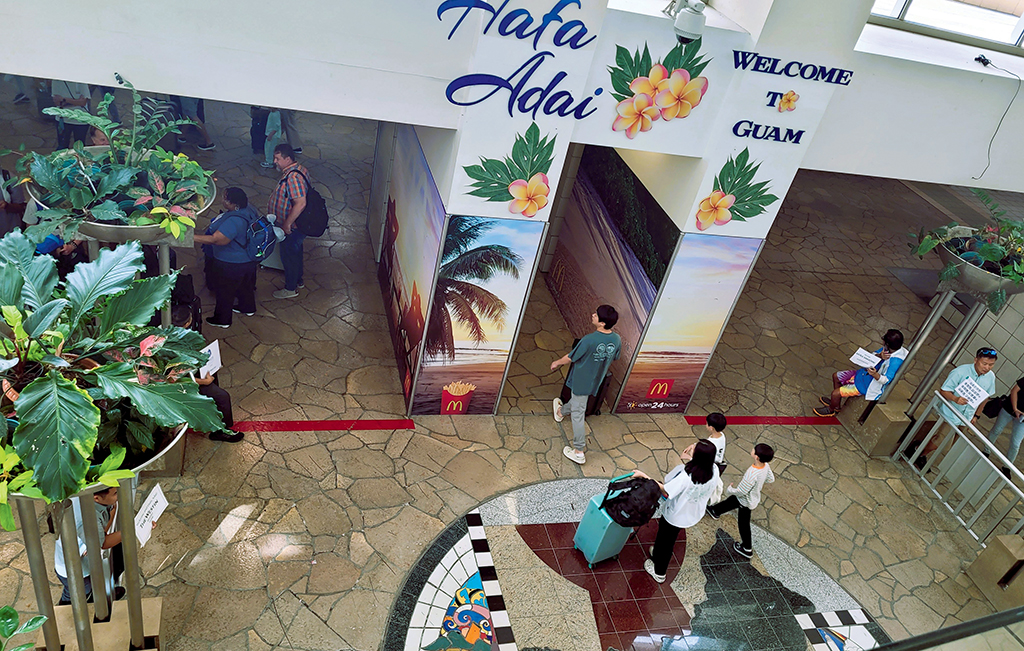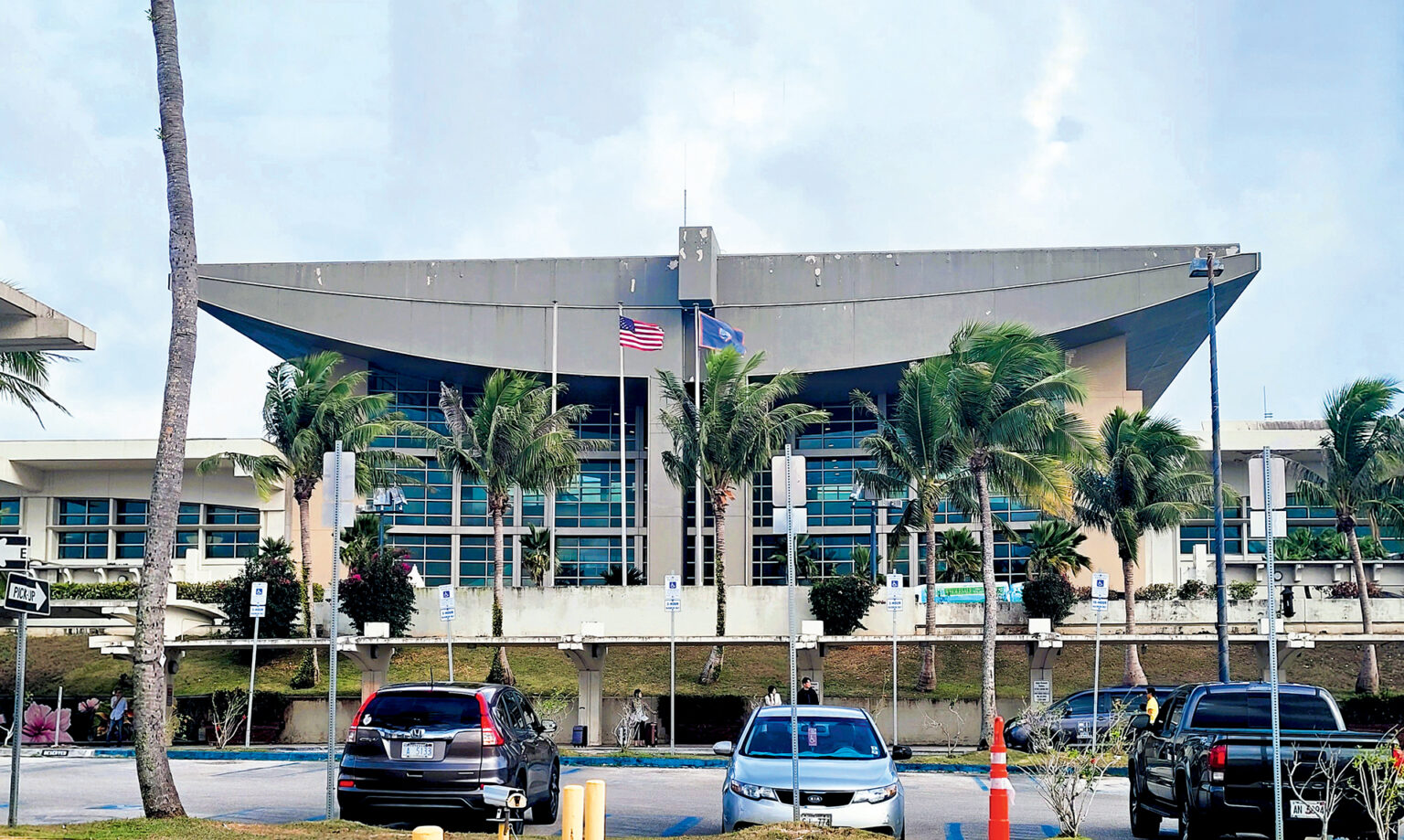Guam officials broke ground on apron and taxiway rehabilitation work at the Antonio B. Won Pat International Airport on March 29, a federally funded project that forms part of the Biden Administration’s $15 billion five-year initiative to modernize America’s aviation system.
Sumitomo Mitsui Construction Co. Ltd. leads the $41.1 million undertaking, with GHD Guam serving as construction manager.

“This is one of our larger projects,” says Artemio “Ricky” Hernandez, deputy executive manager of the Guam International Airport Authority (GIAA). “The apron project really is a safety-related project.”
UPGRADING THE APRON
A runway apron is used for parking, loading/unloading, refueling and boarding aircraft. According to authorities, the current building’s layout is not aircraft-friendly, considering the amount of distance between its cargo facility and the parking area for cargo planes. The project calls for shortening the distance to promote more efficient cargo handling operations.
“[There are] inefficiencies to get cargo to and from our cargo building,” Hernandez explains. “We’re actually going to construct a huge slab of asphalt and concrete where cargo planes can park … adjacent to the cargo building.”
Another component of the project is the extension of fuel lines, which includes the installation of hydrants at different locations along the cargo apron to refuel airplanes on the spot, instead of using fuel trucks.
“When we do our planning for capital improvement projects, our goal is not only to try to meet the demand of visitor and cargo traffic, but also to ensure that we have safety and security top-of-mind,” Hernandez says.
The apron and taxiway rehabilitation project is funded with a $31.1 million grant via the Federal Aviation Administration (FAA) Airport Improvement Program, plus $10 million in matching funds from GIAA.
“The project is starting and we’re excited about it,” says Hernandez. “I think it’s going to be looking at an 18-month time horizon for that.”
A GROWING FACILITY
The Guam airport is a hub for United Airlines and Asia Pacific Airlines. It is located in Barrigada, three miles from the capital village of Hagatna.
In 2023, GIAA recorded close to 900,000 enplanements, which was half the pre-pandemic levels.
“Guam can handle more. We have excess capacity,” Hernandez says. “We’re targeting over 1 million enplanements in 2024 — or it could be 1.1 million to 1.2 million, depending on how things go.”
Guam’s first international air terminal opened in 1967, with a new passenger terminal building added in 1982. Another terminal resulted from a $241 million expansion project that was completed in September 1998 — and at the time, it was the largest single capital improvement project ever completed on the island.
PROJECTS COMPLETED
GIAA continuously embarks on capital improvement projects to keep up with air traffic growth. Three major undertakings have been completed in the past two years.
In March 2023, contractor Hawaiian Rock completed an $11 million rehabilitation of primary runway 6L/24 at the airport. Its surfaces and shoulders were hardened to accommodate fully loaded, long-range flights from the continental United States.
In January 2022, GIAA officially opened the airport’s International Arrivals Corridor, which was created to separate arriving and departing passengers. The new layout includes an elevator from passenger gates to a sterile corridor that leads incoming passengers directly to U.S. Customs and Border Protection. The $130 million project was completed by Black Construction Corp.
In August 2022, airport officials cut the ribbon to mark the opening of a new $27.2 million aircraft firefighting facility built by BME & Sons Inc., with KHLG & Associates Inc. performing construction management services.
The new facility, which houses the airport’s aircraft rescue and firefighting unit, boasts state-of-the-art equipment and operations with the latest technology and its own water reservoir for efficient response to all points of the airfield and terminal facilities.

PROJECTS UNDERWAY
Along with the ongoing apron and taxiway rehabilitation, GIAA has identified other priority projects that are now out for bid, including the terminal roofing system replacement.
The FAA recently awarded GIAA $21.4 million under its Airport Terminals Program for a roofing project.
“Our roof is really old and needs to be replaced. Even with regular rain, we do get some leaks,” Hernandez says.
The project also covers the installation of solar panels.
“The initiative aims to enhance the GIAA’s resilience to extreme weather events, ensuring uninterrupted operations and passenger safety while providing a safe and secure facility that meets Guam Building Codes,” according to a news release.
Under the ATP grant, the cost split for the terminal roofing project is 95 percent from federal funds and 5 percent from GIAA capital improvement funds.
“Although we got over $21 million, the overall project cost is likely double that price,” Hernandez says. “We continue to work with the FAA and other partners to see how we can bridge the funding for the remainder of the project.”
The new project list also includes minor tasks such as floor resurfacing and painting at the passenger arrival area. Both are out for bid.
“These are Typhoon Mawar-related projects,” Hernandez says.
GIAA received $4 million in direct appropriations from Congress in April through Congressional community project funding for fiscal year 2024.
The grant amount is broken down into two projects: $2 million for an “accessibility study” and another $2 million for updating the airport’s fire alarm and fire suppression infrastructure.
The project also includes integration of all facilities and centralization of command and control under the airport’s jurisdiction. This would essentially modernize Guam’s 25-year-old system.
The mandated accessibility study would identify the requirements for improved and expanded airport accessibility for individuals with disabilities, including designs and specifications to improve parking facilities, provide covered curbside canopies, address a digital signage content management system, upgrade restrooms and install service animal relief areas.
“The one thing we’re excited about is having a canopy cover over certain parts of the departures and potentially the arrivals area,” Hernandez says. “When there’s inclement weather like rain, that’ll help with some of the passenger experience and helps with accessibility to the airport terminal.”
THE MASTER PLAN
Hernandez says the airport authority is finalizing its FAA-funded master plan that will guide future projects in the next 20 years based on air traffic forecasts.
“The goal of our master plan is to ensure that we meet the forecast demand,” the airport deputy general manager says. “We look at a 20-year horizon, but we have short-, medium- and long-term goals.”
The master plan is almost done, but there are still parts that require FAA approvals, Hernandez says.




